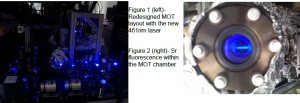Jarom Jackson and Dr. Dallin Durfee, Physics
Introduction
The purpose of this project was to produce a slow controlled beam of Strontium (Sr) ions. This is a key step in a proposed experiment to build an ion interferometer capable of measuring electric fields to a degree of sensitivity that has never been done before. This device will be useful in conducting a number of new experiments and will help test and push the boundaries of modern electromagnetic theory.
Due to some unfortunate setbacks, the timetable of this project was pushed back considerably. Such is the nature of experimental physics, however, and we are back on track and excited about the future possibilities of what we can accomplish.
Methodology
The ion beam will be generated from a magneto-optical trap (MOT) of laser cooled atoms. This can be done by putting a small hole in the trapping potential—in this case with a small hole in the center of one of the laser beams. The atoms from the trap can then leak out through this hole, forming a slow, controlled atom source. The atom beam will then be photo-ionized with a pair of lasers tuned to the correct frequency to form an ion beam.
The formation of a MOT requires high vacuum, sufficient vapor pressure of the element to be trapped and a very narrow linewidth laser tuned slightly off resonance of the atomic transition. At the beginning of the project, the laser and vacuum systems were already in place, but issues with both required significant work to be redone on them.
Vacuum
Shortly after the beginning of the project one of the vacuum windows on the MOT chamber imploded, spreading shattered glass throughout the chamber, and contaminating it with air from the lab. We believe this was caused by the malfunctioning of a window heater that caused the window to be heated far above its safe limit. To restore the vacuum system required us to remove the chamber completely, clean it again with acid and go through the bake-out procedure necessary to achieve high-vacuum conditions. As part of this process we decided to upgrade the chamber with new windows that allow us to reach higher vacuum than the previous ones did. Baking is a process done to remove oxygen and other contaminates that absorb into the walls of a vacuum chamber. The bake-out was done in about eight hour increments during the day to minimize risk of electronic failure causing damage when no one was around to prevent it. This was done over a two week period with the chamber heated to a little over 200°C, and the windows to about 170°C.
Laser
The system we were originally using was an IR diode in a standard external cavity diode laser (ECDL) setup. The 461nm blue light was produced from the IR laser with a doubling crystal. With this laser we were able to cause Sr fluorescence. However, due to the various steps involved in producing the light, and the imperfections at each step, the laser tended to be very unstable and difficult to scan. Despite significant work done on improving the laser, including a redesigned and rebuilt locking circuit I built as part of this project the instability of the laser proved to be a significant obstacle. Due to this instability, we eventually decided to replace the laser. We set up the new laser over the summer and have a good success with it so far.
Results
Before the vacuum implosion, the vacuum chamber pressure would only go down to about 2E-7 Torr. After replacing the windows and cleaning the chamber it pumped down to a pressure of 5E-6 Torr, using the turbo and roughing pumps. After bake-out, the chamber is now down to 5E-8 Torr with just the ion pump running. This is better than a factor of 2 improvement over what we were able to achieve before the vacuum accident.
With the new windows and the new laser now in place (see figure 1) we have been able to detect the Sr in the MOT chamber and tune the laser to cause it to fluoresce (see figure 2). This means that everything is in place and ready to trap atoms.
We presented our progress at the 2013 meeting of the American Physical Society’s Division of Atomic Molecular and Optical Physics in Quebec city, Canada.
Discussion
Despite the setbacks in this project we are making steady progress towards our goal. Over the past year we have, unfortunately had to redo a lot of work that had been done previously. In the process, however, we have made important improvements in the vacuum and laser systems.
There is still a lot of work to be done, but we are close to getting publishable results. We have the MOT chamber ready and the trapping optics in place. The new laser is set up and tuned. We are currently working on making the MOT (a tedious process of tweaking optical alignment, electronics and laser tuning to get the conditions just right), and will then be ready to image and characterize the atom beam.

